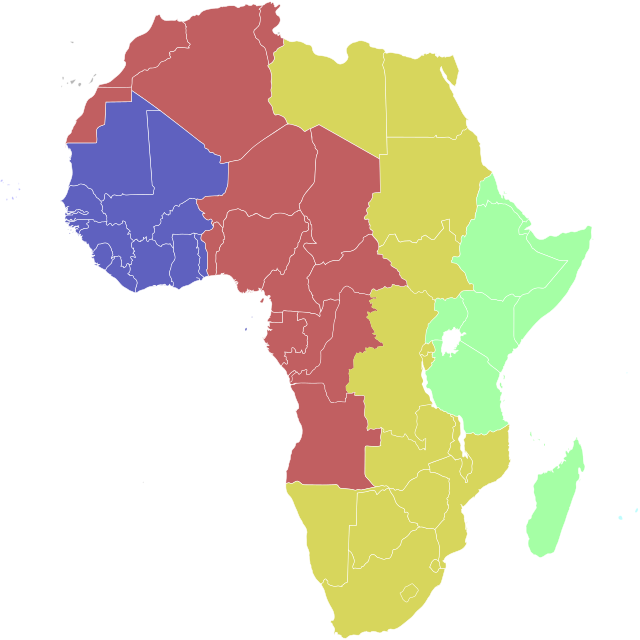Top Qs
Timeline
Chat
Perspective
East Africa Time
Time zone From Wikipedia, the free encyclopedia
Remove ads
East Africa Time (EAT) is a time zone used in eastern and central Africa, with a standard offset of UTC+03:00 from Coordinated Universal Time (UTC). It is one of the most widely used time zones in Africa, adopted by countries including Kenya, Tanzania, Uganda, Ethiopia, Somalia, and others. EAT does not observe daylight saving time (DST), maintaining a consistent offset year-round due to the region’s equatorial proximity, which results in minimal variation in daylight hours.[1] In the IANA time zone database, EAT is represented by the canonical identifier Africa/Nairobi, with aliases such as Africa/Kampala and Africa/Dar_es_Salaam.[2][3]

| Light Blue | Cape Verde Time[a] (UTC−1) |
| Blue | Greenwich Mean Time (UTC) |
| Red | (UTC+1) |
| Yellow | (UTC+2) |
| Ochre | (UTC+3) |
| Green | East Africa Time (UTC+3) |
| Turquoise | (UTC+4) |
b Locally known as Egypt Standard Time.
c Mauritius and the Seychelles are to the east and north-east of Madagascar respectively.
The time zone is three hours ahead of UTC (UTC+03:00), which is the same as Moscow Time, Arabia Standard Time, Further-eastern European Time and Eastern European Summer Time.[3]
Remove ads
Geographical scope
East Africa Time is used as the standard time zone in the following countries and territories:[1]
 Comoros
Comoros Djibouti
Djibouti Eritrea
Eritrea Ethiopia
Ethiopia Kenya
Kenya Madagascar
Madagascar Mayotte (French overseas department)
Mayotte (French overseas department) Somalia
Somalia South Sudan
South Sudan Sudan
Sudan Tanzania
Tanzania Uganda
Uganda
Sudan transitioned to EAT (UTC+03:00) in 2017, aligning with South Sudan and other EAT countries, but reverted to UTC+02:00 in 2020; however, recent sources confirm Sudan’s return to EAT.[1] All listed countries use EAT year-round, with no plans to adopt DST as of 2025.[4] EAT is also used in parts of Somalia’s autonomous regions, such as Puntland and Somaliland, despite political complexities.[2]
Remove ads
Historical context
Timekeeping in East Africa before colonial rule relied on solar time, with communities using the sun’s position to structure daily activities, given the region’s equatorial latitude (0°–15°N) where daylight varies little.[5] During British and German colonization in the late 19th century, standardized time zones were introduced to support railway and telegraph networks, such as the Uganda Railway in Kenya and Uganda. By the early 20th century, UTC+03:00 was adopted across British East Africa (Kenya, Uganda, Tanzania), aligning with geographical longitude (30°E–45°E) and becoming known as East Africa Time.[1] Post-independence, EAT was retained for regional consistency, with countries like Ethiopia and Somalia adopting it to facilitate coordination.[5]
Remove ads
Cultural and economic impacts
The equatorial location of EAT countries, with sunrise and sunset occurring around 6:00 AM and 6:00 PM, shapes cultural perceptions of time. In rural areas, agricultural schedules dominate, with activities like planting and harvesting tied to seasonal rains rather than strict clock time. Urban centers, such as Nairobi, Dar es Salaam, and Kampala, follow standard business hours (typically 8:00 AM–5:00 PM), but informal sectors like markets often operate on flexible schedules.[5] Religious practices, particularly Islamic prayers in Somalia and Comoros, structure daily routines, with Salah times influencing work breaks.[5] Economically, EAT’s uniformity across the East African Community (EAC)—Kenya, Tanzania, Uganda—enhances trade, logistics, and cross-border investments.[2] The shared time zone with Ethiopia, a major African economy, further supports regional integration.[1]
Technical details
In the IANA time zone database, EAT is defined by the canonical identifier Africa/Nairobi, with aliases including Africa/Kampala, Africa/Dar_es_Salaam, and Africa/Mogadishu.[2] This ensures consistent time representation in digital systems, such as operating systems and smartphones, which automatically adjust to UTC+03:00 in EAT regions. The time zone corresponds to a longitudinal range of approximately 30°E to 45°E, aligning with the region’s geographical position.[1] The equatorial latitude (0°–15°N) results in stable sunrise and sunset times, typically 6:00 AM to 6:30 PM, eliminating the need for DST.[2] Network time protocol (NTP) servers in major cities like Nairobi ensure precise time synchronization for critical infrastructure.[5]
Remove ads
See also
- Moscow Time, an equivalent time zone covering Belarus, Turkey and most of European Russia, also at UTC+03:00
- Arabia Standard Time, an equivalent time zone covering Bahrain, Iraq, Kuwait, Qatar, Saudi Arabia and Yemen, also at UTC+03:00
- Eastern European Summer Time, an equivalent time zone covering European and Middle Eastern countries during daylight saving, also at UTC+03:00
- Israel Summer Time, an equivalent time zone covering the State of Israel during daylight saving, also at UTC+03:00
- Further-eastern European Time, an equivalent time zone covering extended Eastern European countries, also at UTC+03:00
- Time in Kenya
- Time in Tanzania
- Time in Uganda
- Time in Ethiopia
- Time in Africa
Remove ads
References
Wikiwand - on
Seamless Wikipedia browsing. On steroids.
Remove ads
